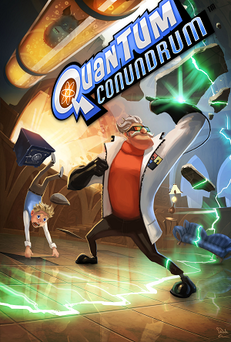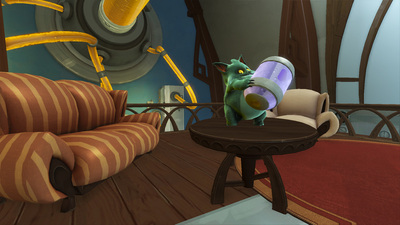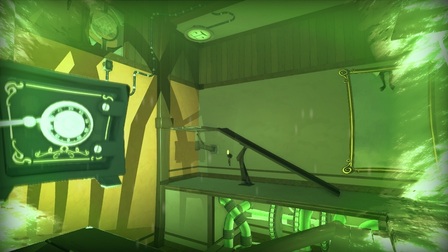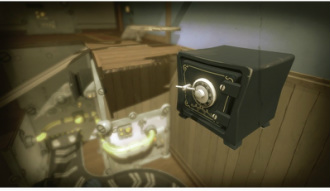| Quantum Conundrum The top PC Games: Last Update July 27, 2012 | Release date(s) Microsoft Windows (Steam) June 21, 2012 PlayStation 3 (PSN)
July 11, 2012 |

TECHNICAL
Intel Core 2 Duo 2.2 Ghz / AMD Athlon 64 x2 3800
2GB RAM
GeForce 8800 GT / ATI Radeon HD 2900 512MB
Windows 7 SP1
Recommended config:
Intel Core 2 Duo E8400 3 GHz
2 GB RAM
nVidia GeForce 9500 GT / ATI Radeon HD 2900
- Description: Quantum Conundrum PC is a adventure/puzzle game in first person in which the player must solve puzzles by moving from a "dimension" to another.These dimensions can affect the physical (the weight of objects, inverted gravity) or on the passage of time.
- Publisher: Square Enix
- Developer: Airtight Games
- Type: Reflection
- France Released: June 21, 2012
Intel Core 2 Duo 2.2 Ghz / AMD Athlon 64 x2 3800
2GB RAM
GeForce 8800 GT / ATI Radeon HD 2900 512MB
Windows 7 SP1
Recommended config:
Intel Core 2 Duo E8400 3 GHz
2 GB RAM
nVidia GeForce 9500 GT / ATI Radeon HD 2900
| Concept: A Portal-style game that lets players warp the density of objects, slow down time, and alter gravity. Mastering these dimensions will help you navigate a neurotic professor’s labyrinthine mansion. Graphics: A simplified cartoon design gets the job done, and it’s fun to see how the design of environmental objects – especially wall paintings – changes through the four different dimensions. | Sound: Actor John de Lancie does a great job portraying Professor Fitz Quadwrangle. The game’s music is playful if largely unmemorable. Playability: Plaforming moments could use some work, but cycling through dimensions and testing how they work is easy and fun. | Entertainment: It’s a lot of fun to switch through four different dimensions (five if you count our own) and experiment with how they play off each other. Solving some of the challenging late-game puzzles is also highly rewarding. Replay: Moderate. |
| Plot: The silent player-protagonist is the twelve-year-old nephew of the brilliant but peculiar Professor Fitz Quadwrangle .He is sent to stay with Quadwrangle, who is unprepared for his arrival as he is presently working on an experiment. The experiment goes awry, causing Quadwrangle to become trapped in a pocket dimension with a loss of memory of what went wrong before, but able to watch and communicate to the protagonist. The results of the experiment leave portions of the Quadwrangle mansion in flux between several dimensions with alternate properties. Quadwrangle guides the protagonist to acquire a glove that can tame these fluxes through which he can then safely travel through the labyrinth of rooms to reach three separate power generators and restart each, which Quadwrangle believes will allow him to escape the pocket dimension. The protagonist also gains help from IKE (Interdimensional Kinetic Entity), a small alien creature that Quadwrangle had adopted as a pet during his travels. As Quadwrangle guides his nephew, he tries to recall the exact events leading to the current situation. After starting the three generators, the house begins to shake, and Quadwrangle realizes that a fourth generator must be started. The protagonist begins to activate the device, but Quadwrangle remembers too late that restarting the device had nearly killed him before and he had escaped to the pocket dimension for safety. With the device started, the house begins to shake violently, and Quadwrangle instructs his nephew to the safety of the pocket dimension, where he will be safe, while Quadwrangle can now work out how to resolve the problems of the half-ruined mansion. | Click the above link to Buy and Download |
Insights:
This Game Is Filled With Puzzles, But Buying It shouldn’t be
The thrill of a good puzzle is something of a mystery. Many gamers enjoy brainteasers, but the act of solving one is rarely enjoyable. A good puzzle makes us stretch the analytical parts of our brain in ways that sometimes feel like work. An unsolved puzzle makes us feel stupid and incapable. Being stuck without a solution is uncomfortable, and yet after we reach that “Eureka!” moment, all is forgiven. All those uncomfortable moments spent pulling our hair and biting our nails were worth it, because that brief second of insight has proven how clever we are. Quantum Conundrum is a game filled with these seconds. It gives your brain a workout, but you’ll love it.
It’s hard to talk about Quantum Conundrum without drawing comparisons to Portal. Not only is the game’s creative director, Kim Swift, one of the DigiPen students Valve originally hired to create the Portal series, but the game has you wandering through a series of rooms and solving physics-breaking puzzles while a disgruntled, disembodied voice walks you through the experience.
This Game Is Filled With Puzzles, But Buying It shouldn’t be
The thrill of a good puzzle is something of a mystery. Many gamers enjoy brainteasers, but the act of solving one is rarely enjoyable. A good puzzle makes us stretch the analytical parts of our brain in ways that sometimes feel like work. An unsolved puzzle makes us feel stupid and incapable. Being stuck without a solution is uncomfortable, and yet after we reach that “Eureka!” moment, all is forgiven. All those uncomfortable moments spent pulling our hair and biting our nails were worth it, because that brief second of insight has proven how clever we are. Quantum Conundrum is a game filled with these seconds. It gives your brain a workout, but you’ll love it.
It’s hard to talk about Quantum Conundrum without drawing comparisons to Portal. Not only is the game’s creative director, Kim Swift, one of the DigiPen students Valve originally hired to create the Portal series, but the game has you wandering through a series of rooms and solving physics-breaking puzzles while a disgruntled, disembodied voice walks you through the experience.

Fortunately, Quantum Conundrum has enough going for it that it stands on its own. The main protagonist is a 12-year-old boy who comes to visit his uncle, the brusque Professor Fitz Quadwrangle, at his mansion laboratory. A failed scientific experiment has trapped the professor into a pocket dimension. Using the professor’s latest invention, the Interdimensional Shift Device (IDS), you work your way through his twisted mansion, solving puzzles by flipping through a series of oddball dimensions, and eventually returning the professor to reality. The professor talks you through the history of his manor with some occasionally amusing dialogue, but the narrative isn’t this game’s strong suit.
Quantum Conundrum’s main attraction is its dimension-jumping puzzles. Using the IDS device, you can shuffle through four different dimensions, each with its own unique properties. For example, the fluffy dimension turns everything softer than a roll of Charmin, while the heavy dimension makes everything 10 times denser and heavier. The puzzles make creative use of these dimensions. In one room you might have to reach a high ledge. If you switch over to the fluffy dimension you can drag large pieces of furniture over an industrial floor fan and hitch a ride as it floats towards the ceiling like a feather. I loved discovering how these dimensions worked in conjunction with one another. To get across large gaps, for example, you can switch over to the fluffy dimension, pick up a heavy object and throw it, then switch over to a dimension where everything moves at a snail’s pace and use the suspended object as a floating platform. These dimensions work together in a number of ways, but figuring out how they play off each other is half the fun of solving Quantum Conundrum’s brainteasers.
Quantum Conundrum’s main attraction is its dimension-jumping puzzles. Using the IDS device, you can shuffle through four different dimensions, each with its own unique properties. For example, the fluffy dimension turns everything softer than a roll of Charmin, while the heavy dimension makes everything 10 times denser and heavier. The puzzles make creative use of these dimensions. In one room you might have to reach a high ledge. If you switch over to the fluffy dimension you can drag large pieces of furniture over an industrial floor fan and hitch a ride as it floats towards the ceiling like a feather. I loved discovering how these dimensions worked in conjunction with one another. To get across large gaps, for example, you can switch over to the fluffy dimension, pick up a heavy object and throw it, then switch over to a dimension where everything moves at a snail’s pace and use the suspended object as a floating platform. These dimensions work together in a number of ways, but figuring out how they play off each other is half the fun of solving Quantum Conundrum’s brainteasers.

Serious puzzle fans will be happy with some of the late-game challenges, which require thinking outside the box. I just wish the game relied more on creative thinking and logical problem-solving, because many puzzles involve a significant amount of manual dexterity, requiring you to time your throws or land on a specific platform. I enjoy platform jumping, but the platforming isn’t as polished as the dimension-altering mechanics. A number of times I missed a jump because the controls didn’t feel tight enough to facilitate this kind of gameplay.
With its physics-warping mechanics, thoughtful brainteasers, and playful atmosphere, Quantum Conundrum should appeal to the legions of Portal fanatics. Some may complain that it’s not as funny or as clever as Valve’s hit series, but Quantum Conundrum is a unique experience that deserves attention nonetheless.
With its physics-warping mechanics, thoughtful brainteasers, and playful atmosphere, Quantum Conundrum should appeal to the legions of Portal fanatics. Some may complain that it’s not as funny or as clever as Valve’s hit series, but Quantum Conundrum is a unique experience that deserves attention nonetheless.

 RSS Feed
RSS Feed